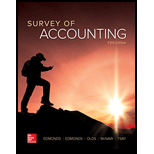
Survey Of Accounting
5th Edition
ISBN: 9781259631122
Author: Edmonds, Thomas P.
Publisher: Mcgraw-hill Education,
expand_more
expand_more
format_list_bulleted
Concept explainers
Question
Chapter 7, Problem 28P
a.
To determine
Provide an example for a
b.
To determine
Provide an example for a contingent liability that is reasonably possible or probable but not reasonably estimable and also explain the manner by which this type of contingent liability will be shown in the accounting records.
c.
To determine
Provide an example for a contingent liability that is remote and also explain the manner by which this type of contingent liability will be shown in the accounting records.
Expert Solution & Answer
Want to see the full answer?
Check out a sample textbook solution
Students have asked these similar questions
Granville Corporation has two divisions: The Beta Division and the Delta Division. The Beta Division has sales of $375,000, variable expenses of $182,500, and traceable fixed expenses of $84,200. The Delta Division has sales of $580,000, variable expenses of $312,700, and traceable fixed expenses of $128,600. The total amount of common fixed expenses not traceable to the individual divisions is $145,500. What is the company's net operating income (NOI)? Please provide answer
None
Financial Accounting problem
Chapter 7 Solutions
Survey Of Accounting
Ch. 7 - 1. What type of transaction is a cash payment to...Ch. 7 - Prob. 2QCh. 7 - How does recording accrued interest affect the...Ch. 7 - 4. Who is the maker of a note payable?Ch. 7 - How does the going concern assumption discussed in...Ch. 7 - 6. Why is it necessary to make an adjusting entry...Ch. 7 - Assume that on October 1, 2018, Big Company...Ch. 7 - Prob. 8QCh. 7 - Prob. 9QCh. 7 - Prob. 10Q
Ch. 7 - 11. Are contingent liabilities recorded on a...Ch. 7 - Prob. 12QCh. 7 - Prob. 13QCh. 7 - Prob. 14QCh. 7 - Prob. 15QCh. 7 - Prob. 16QCh. 7 - 1. What is the difference between classification...Ch. 7 - 2. At the beginning of Year 1, B Co. has a note...Ch. 7 - 3. What is the purpose of a line of credit for a...Ch. 7 - 4. What are the primary sources of debt financing...Ch. 7 - 5. What are some advantages of issuing bonds...Ch. 7 - 6. What are some disadvantages of issuing bonds?Ch. 7 - 7. Why can a company usually issue bonds at a...Ch. 7 - 15. If Roc Co. issued 100,000 of 5 percent,...Ch. 7 - 16. What is the mechanism is used to adjust the...Ch. 7 - 17. When the effective interest rate is higher...Ch. 7 - 18. What type of transaction is the issuance of...Ch. 7 - 19. What factors may cause the effective interest...Ch. 7 - 20. If a bond is selling at 97, how much cash will...Ch. 7 - Prob. 30QCh. 7 - 22. Gay Co. has a balance m the Bonds Payable...Ch. 7 - Prob. 32QCh. 7 - Prob. 33QCh. 7 - Recognizing accrued interest expense Abardeen...Ch. 7 - Prob. 2ECh. 7 - Prob. 3ECh. 7 - Prob. 4ECh. 7 - Prob. 5ECh. 7 - Effect of warranties on income and cash flow To...Ch. 7 - Effect of warranty obligations and payments on...Ch. 7 - Principle due at maturity versus installments...Ch. 7 - Prob. 9ECh. 7 - Amortization of a long-term loan A partial...Ch. 7 - Prob. 11ECh. 7 - Prob. 12ECh. 7 - Prob. 13ECh. 7 - Prob. 14ECh. 7 - Exercise 7-15 Straight-line amortization of a bond...Ch. 7 - Prob. 16ECh. 7 - Prob. 17ECh. 7 - Prob. 18ECh. 7 - Prob. 19ECh. 7 - Prob. 20ECh. 7 - Prob. 21ECh. 7 - Exercise 7-22 Preparing a classified balance sheet...Ch. 7 - Exercise 7-23 Effective interest amortization of a...Ch. 7 - Prob. 24ECh. 7 - Prob. 25ECh. 7 - Prob. 26PCh. 7 - Prob. 27PCh. 7 - Prob. 28PCh. 7 - Problem 7-29 Current liabilities The following...Ch. 7 - Prob. 30PCh. 7 - Prob. 31PCh. 7 - Problem 7-32 Accounting for a line of credit Elite...Ch. 7 - Prob. 33PCh. 7 - Prob. 34PCh. 7 - Problem 7-35 Straight-line amortization of a bond...Ch. 7 - Prob. 36PCh. 7 - Prob. 37PCh. 7 - Prob. 38PCh. 7 - Writing Assignment Definition of elements of...Ch. 7 - Prob. 5ATC
Knowledge Booster
Learn more about
Need a deep-dive on the concept behind this application? Look no further. Learn more about this topic, accounting and related others by exploring similar questions and additional content below.Similar questions
arrow_back_ios
SEE MORE QUESTIONS
arrow_forward_ios
Recommended textbooks for you
 Cornerstones of Financial AccountingAccountingISBN:9781337690881Author:Jay Rich, Jeff JonesPublisher:Cengage LearningPrinciples of Accounting Volume 1AccountingISBN:9781947172685Author:OpenStaxPublisher:OpenStax College
Cornerstones of Financial AccountingAccountingISBN:9781337690881Author:Jay Rich, Jeff JonesPublisher:Cengage LearningPrinciples of Accounting Volume 1AccountingISBN:9781947172685Author:OpenStaxPublisher:OpenStax College Auditing: A Risk Based-Approach (MindTap Course L...AccountingISBN:9781337619455Author:Karla M Johnstone, Audrey A. Gramling, Larry E. RittenbergPublisher:Cengage Learning
Auditing: A Risk Based-Approach (MindTap Course L...AccountingISBN:9781337619455Author:Karla M Johnstone, Audrey A. Gramling, Larry E. RittenbergPublisher:Cengage Learning

Cornerstones of Financial Accounting
Accounting
ISBN:9781337690881
Author:Jay Rich, Jeff Jones
Publisher:Cengage Learning

Principles of Accounting Volume 1
Accounting
ISBN:9781947172685
Author:OpenStax
Publisher:OpenStax College

Auditing: A Risk Based-Approach (MindTap Course L...
Accounting
ISBN:9781337619455
Author:Karla M Johnstone, Audrey A. Gramling, Larry E. Rittenberg
Publisher:Cengage Learning